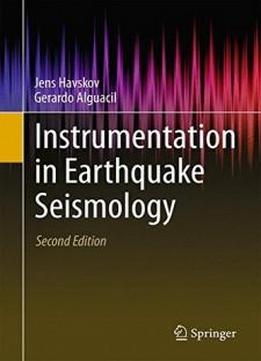
Instrumentation In Earthquake Seismology
by Jens Havskov /
2015 / English / PDF
13 MB Download
This work provides an up-to-date overview of modern instruments
used in earthquake seismology as well as a description of
theoretical and practical aspects of seismic
instrumentation. The main topics are:
This work provides an up-to-date overview of modern instruments
used in earthquake seismology as well as a description of
theoretical and practical aspects of seismic
instrumentation. The main topics are:
• Choosing and installing equipment for seismic stations
• Choosing and installing equipment for seismic stations
• Designing and setting up seismic networks and arrays
• Designing and setting up seismic networks and arrays
• Maintaining and calibrating seismic instruments
• Maintaining and calibrating seismic instruments
It also provides detailed descriptions of the following:
It also provides detailed descriptions of the following:
• Seismic sensors
• Seismic sensors
• Digitizers
• Digitizers
• Seismic recorders
• Seismic recorders
• Communication systems
• Communication systems
• Software used for seismic station and networks
• Software used for seismic station and networks
In this second edition, new seismic equipment is presented and
more comprehensive sections on topics like MEMS accelerometers,
sigma-delta AD converters, dynamic range discussion and virtual
networks have been included.
In this second edition, new seismic equipment is presented and
more comprehensive sections on topics like MEMS accelerometers,
sigma-delta AD converters, dynamic range discussion and virtual
networks have been included.
This book is primarily intended for seismologists, engineers and
technicians working with seismological instruments. It combines
practical “know-how” with sufficient theory to explain the basic
principles, making it also suitable for teaching students the
most important aspects of seismic instrumentation.
This book is primarily intended for seismologists, engineers and
technicians working with seismological instruments. It combines
practical “know-how” with sufficient theory to explain the basic
principles, making it also suitable for teaching students the
most important aspects of seismic instrumentation.
The book also gives a current overview of the majority of
instruments and instrument manufacturers on the market, making it
easy to compare the capability of instruments from different
sources.
The book also gives a current overview of the majority of
instruments and instrument manufacturers on the market, making it
easy to compare the capability of instruments from different
sources.
SEISAN software was used for several examples in the book. This
widely extended seismic analysis software is freely available
from the University of Bergen website.
SEISAN software was used for several examples in the book. This
widely extended seismic analysis software is freely available
from the University of Bergen website.
The content of this book draws on the authors’ (a seismologist
and a physicist) combined experience of working in this field for
more than 35 years.
The content of this book draws on the authors’ (a seismologist
and a physicist) combined experience of working in this field for
more than 35 years.











